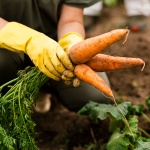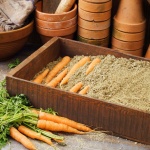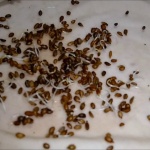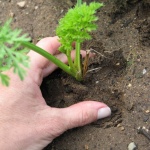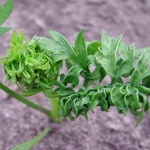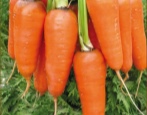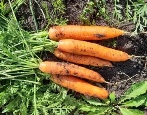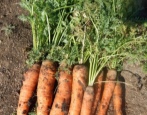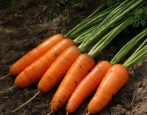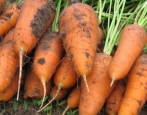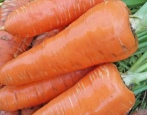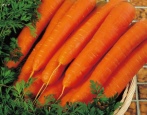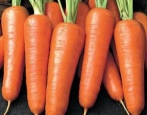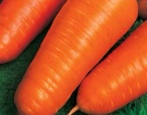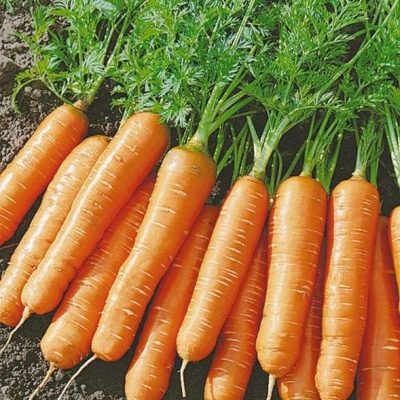
- Authors: Holland
- Name synonyms: Baltimore
- Year of approval: 2010
- Appointment: for fresh consumption, for canning, for freezing, for bundled products, for making juice
- Leaf rosette shape: upright
- Leaves: long, green, fine to medium dissected
- Weight, g: 114-230
- The form : cylindrical with blunt tip
- Taste qualities: good and excellent
- Composition : dry matter 11.7-12.4%, total sugar 7.0-7.7%, carotene up to 22.4 mg per 100 g of raw matter
Carrots are a healthy and tasty vegetable, which always has a special place in the garden ridge, so that you can enjoy natural roots all autumn and winter. Excellent for growing in different climatic conditions is the Dutch hybrid Baltimore, bred not so long ago, but attracting the attention of both gardeners and farmers.
Breeding history
The Baltimore carrot is a first generation hybrid created by Dutch scientists Bejo Zaden B. V. in 2008. After several variety trials, in 2010, the vegetable crop was added to the State Register of approved for use. Carrots are cultivated in nine regions - from Central Black Earth to the Far East. The vegetable is grown both in small garden beds and in farm fields. The hybrid is maximally productive in the Central region. In addition, carrots are happily cultivated in Ukraine, Moldova, and Belarus.
Description of the variety
The Dutch hybrid is a plant with a powerful erect leaf rosette, which grows up to 33-35 cm in height. The leaves of the plant are elongated, with a characteristic rich green color and small / medium dissection of the plates. The foliage does not have a pronounced aroma. The hybrid belongs to the transitional cultivar Berlikum / Nantes. According to experts, the Baltimore carrot is an improved analogue of the popular Nandrin hybrid.
Thanks to the massive tops, root crops can be harvested mechanically.
Characteristics of the appearance of the plant and root crops
This hybrid belongs to large-fruited. Carrots ripen leveled and neat, for which they are highly valued by farmers and agrarians who grow crops on an industrial scale. The average weight of root crops varies between 114-230 grams. The length of the fruit is elongated - 20-25 cm, and the diameter is up to 5-6 cm. The shape of the carrot is cylindrical with a blunt "nose". Ripe tubers are evenly colored with a rich orange color. The bark of the fruit is thin and delicate, smooth, with shine. Light eyes are barely visible on the surface, but there are no lateral filamentous roots.
The harvested root vegetables are easily transported over different distances, and can also be stored for a long time if the correct storage conditions are observed (dry, cool and dark place). The hybrid is ideal for winter storage, while vegetables do not deform, no cracks appear on the surface.
Purpose and taste of tubers
Baltimore is known to many growers for its excellent taste. The bright orange pulp has a tender, crispy, fleshy and very juicy consistency without fiber, wateriness or voids. The core of the fruit is thin, not very different in color and structure from carrot pulp. The taste is dominated by bright sweetness and pleasant sugariness, intertwined with a pronounced carrot aroma.
Grown carrots can be widely used in cooking - add to cold and hot dishes, pickle, freeze, use in canning, and vegetables are good for long-term storage. Due to their incredible juiciness and meatiness, they are ideal for processing into juices and purees, for baby and diet food.
Maturation
Baltimore is a mid-season carrot. The growing season lasts only 103 days.After 85-90 days, you can taste the first fruits as early ripe, and the massive harvest takes place later, in mid-September - early October.
Yield
The variety is claimed to be high yielding. In a favorable environment, 6-10 kg of crunchy root vegetables can be harvested from 1 m2 of plantings. On an industrial scale, you can count on an average of 336-604 c / ha.
Growing and care
The hybrid is cultivated through direct seeding. For this, a site is prepared in advance - it is cleared of weeds and other debris, dug up, fertilized and elongated grooves up to 2-3 cm deep are made.The distance between the rows does not exceed 20 cm. Sowing is carried out according to the scheme 5-7 by 15-20 cm. Planting carrots is recommended in early June, although many vegetable growers recommend sowing in May. The best precursors for a carrot hybrid are cucumbers, tomatoes, onions, or cabbage.
The variety is suitable for winter sowing. This will allow you to get fresh and healthy carrots early. Sowing of seeds is carried out in mid-November, when a sharp warming is unlikely. For this, furrows are prepared, where seeds are sown, and then covered with warm soil. Shelter with geotextiles or polyethylene will help speed up germination in spring. In spring, the soil is slightly fluffy, which will increase air permeability, as well as accelerate the growth and development processes.
Caring for a vegetable consists of standard measures: watering with settled water every 3-4 days, fertilizing (2-3 times during the growing season), loosening and weeding the soil, thinning the plantings twice a season, keeping the distance between plants 4-6 cm, prevention diseases and insect infestations.
It is worth not forgetting that if fertilizers were applied to the soil in the fall, then the vegetable crop does not need additional fertilizing during cultivation. In addition, moisture-loving carrots are best watered using a drip system.
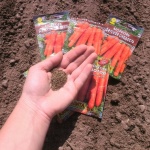
Carrots are one of the most unpretentious crops in terms of growing conditions; they can endure a short drought and a short cold snap. However, to get tasty and large root crops, you should adhere to the basic rules for planting carrots.

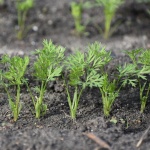
Soil requirements
Carrots Baltimore, like many of its relatives, prefers to grow in light loamy or sandy loam soils, which are characterized by good air permeability and nutritional value. In addition, the soil should have neutral acidity and moisture permeability. The culture is very susceptible to heavy and swampy substrates.
Required climatic conditions
The Baltimore hybrid is a rather thermophilic and light-loving culture, therefore it is recommended to grow it exclusively in areas well-lit by the sun. Even a slight partial shade can negatively affect development and productivity. The most comfortable for carrots will be a plot on a plain or a small hill.
Disease and pest resistance
The variety has good immunity. The vegetable culture is resistant to powdery mildew and various types of spotting. In addition, root vegetables are nematode tolerant. It is also worth noting the resistance to shooting and cracking.
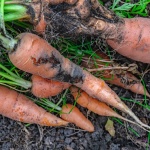
Carrots grow in almost any garden. There is an opinion that this culture is very resistant to all kinds of diseases and pests, but this is not the case.Without proper care, carrots become susceptible to all kinds of infections and are affected by harmful insects.
